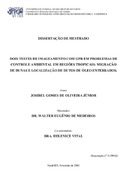Please use this identifier to cite or link to this item:
https://repositorio.ufrn.br/handle/123456789/18778| Title: | Dois testes de imageamento com GPR em problemas de controle ambiental em regiões tropicais: migração de dunas e localização de dutos de óleo enterrados |
| Authors: | Oliveira Júnior, Josibel Gomes de |
| Advisor: | Medeiros, Walter Eugênio de |
| Keywords: | Radar penetrante no solo;Migração de dunas;dutos de óleo |
| Issue Date: | 21-Feb-2001 |
| Publisher: | Universidade Federal do Rio Grande do Norte |
| Citation: | OLIVEIRA JÚNIOR, Josibel Gomes de. Dois testes de imageamento com GPR em problemas de controle ambiental em regiões tropicais: migração de dunas e localização de dutos de óleo enterrados. 2001. 95 f. Dissertação (Mestrado em Geodinâmica; Geofísica) - Universidade Federal do Rio Grande do Norte, Natal, 2001. |
| Portuguese Abstract: | O principal objetivo deste trabalho, é testar o método GPR (Ground Penetrating Radar) em ambientes com clima tropical. Desta forma, foram escolhidas duas localidades distintas que apresentam problemas considerados padrões para a aplicação do GPR. A natureza não invasiva deste método, aliada ao baixo custo, rapidez e facilidade de operação, torna-o adequado para os trabalhos aqui propostos. A primeira localidade está situada no município de São Bento do Norte e o problema relacionado a ela consiste na caracterização de estruturas internas de dunas. Seções de GPR com antena de 400 Mhz foram levantadas nas direções E-W, N-S, NE-SW e SE-NW. Estes perfis interceptaram-se no topo da duna e possibilitaram estabelecer relações entre a sua estrutura interna e a sua direção de migração, associada ao vento dominante na área. Foi possível identificar também contatos laterais entre dunas de diferentes gerações, assim como bounding surfaces, nível freático e mergulho de camadas. Na segunda localidade, de nome Estreito (próximo ao município de Carnaubais), foram levantadas seções de GPR com antenas de 200 Mhz e 400 Mhz para detectar dutos antigos de petróleo enterrados em uma área agricultável. Os perfis de GPR foram realizados perpendicularmente à suposta direção dos dutos e, da sua interpretação, determinous-se a posição de seis oleodutos de diferentes diâmetros (4", 10" e 16") enterrados, cujas posições exatas eram desconhecidas, assim como a produndidade em que estes se encontravam (variando de 1,2m e 1,5m). No tratamento dos dados foi adotado um processsamento semelhante àqueles utilizado nos métodos sísmicos (ajuste do tempo zero, ganho, migração, correção topográfica, dewow, deconvolução e filtros passa-banda). Este processamento permitiu estabelecer relações entre os refletores contidos nas seções de GPR e estruturas geológicas (ou não) presentes nos ambientes. A correção topográfica possibilitou identificar com precisão estruturas planas (como o nível freático), ao passo que a migração dos dados proporcionou a exata posição dos dutos |
| Abstract: | Because the penetration depth of Ground Penetrating Radar (GPR) signals is very limited in high conductive soils, the usefullness of this method in tropical regions is not yet completly known. The main objective of this researh is to test the usefullness of the method in Brazil. Two typical problems where GPR has been used in Europe and North American were choosed for this test: the first one is to characterize the internal structures of a sand body and the second problem is the localization of old buried pipes lines. The first test was done near the city of São Bento do Norte, in the northern coast of Rio Grande do Norte state, NE Brazil. In this region, there is a sand dune that is migrating very fast in the direction of adjacent settling areas. To characterize the internal structure of the dune and its relationship to the prevailing wind direction, as a preliminary step to understand the dune migration, GPR profiles using the 400 MHz frequency were performed in E-W, N-S, NE-SW, and SE-NW directions over the sand dune intersecting at the top of the dune. The practical resolution of the GPR data is around 30 cm; this was sufficient to distinguish individual foresets inside the dune. After applying the elevation correction to the data, we identified that dips of bedding structures are smallest for the N-S profile, which is perpendicular to the dominant wind direction, largest for the E-W profile, and intermediate for the SW-NE and SE-NW profiles. Foresets in the E-W profile dip with angles varying from 2 to 6 degrees. In the E-W profile, the water table and a horizontal truncation interface separating two generations of dunes were identified, as well as an abrupt directional change in the foreset patterns associated to a lateral contact between two dune generations, the older one extending to the west. The used high frequency of 400 Mhz does not allow a penetration deep enough to map completely these internal contacts. The second test was done near Estreito, a small town near Carnaúbais city, also in Rio Grande do Norte state. In this locality, there are several old pipe lines buried in area covered by plantations where digging should be minimized. Several GPR profiles using the 400 and 200 MHz frequency were performed trying to intercept perpendicularly the possible pipe lines. Because of the high conductivity of the soil, the raw original data can hardly be use to identify the pipe lines. However, after an adequate processing over the 200 MHz profiles, six pipe lines were identified. As a global result of the tests, GPR can be very usefull if the conductivity of the ground is low or, in the case of medium conductivities of the soils, if adequate processing is performed |
| URI: | https://repositorio.ufrn.br/jspui/handle/123456789/18778 |
| Appears in Collections: | PPGG - Mestrado em Geodinâmica e Geofísica |
Files in This Item:
| File | Description | Size | Format | |
|---|---|---|---|---|
| JosibelGOJ.pdf | 1,76 MB | Adobe PDF |  View/Open |
Items in DSpace are protected by copyright, with all rights reserved, unless otherwise indicated.

